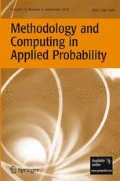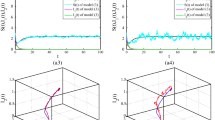Abstract
This paper analyses a stochastic eco-epidemic model with biological control. The deterministic model is already investigated thoroughly and we mention here some important results. Here we demonstrate the nature of the limit cycle emerging through Hopf bifurcation which is not addressed before. Furthermore, we develop the stochastic model by introducing white noise in the deterministic system. The existence of a unique global positive solution and ultimate boundedness are examined for the stochastic model. Asymptotic mean square stability of the positive equilibrium point is discussed. Finally, numerical simulations are carried out to validate the results obtained.





Similar content being viewed by others
Data Availability
NA.
References
Afanas'ev VN, Kolmanowski VB, Nosov VR (1996) Mathematical Theory of Global Systems Design, Kluwer Academic. Dordrecht
Anderson RM, May RM (1980a) Infectious diseases and population cycles of forest insects. Science 210:658–661
Anderson RM, May RM (1980b) The population dynamics of microparasites and their invertebrate hosts. Philos Trans R Soc Lond Ser B 291:451–524
Beretta E, Kolmanovski V, Shaikhet L (1998) Stability of epidemic model with time delays influenced by stochastic perturbations. Math Comp in Simul 45:269–267
Brodeur J et al (2018) Trends in biological control: public interest, international networking and research direction. BioControl 63:11–26
Burges HD (1981) Microbial Control of Pest and Plant Disease. Academic Press. London, New York
Carletti M (2002) On the stability properties of a stochastic model for phage-bacteria interaction in open marine environment. Math Biosci 175:117–131
Chen-Charpentier BM (2021) Stochastic modelling of plant virus propagation with biological control. Mathematics 9:456. https://doi.org/10.3390/math9050456
Cui Y, Liu SH, Tang JS, Meng YM (2009) Amplitude control of limit cycles in Langford system. Chaos, Solitons Fractals 42:335–340
Dwyer G, Dushoff J, Yee SH (2004) The combined effects of pathogens and predators on insect outbreaks. Nature 430:341–345
Glare JR, Jackson TA (1992) Use of Pathogens in Scarab Past Management. Intercept Ltd., Andover, Hampshire, UK
Hajek AE, St RJ (1994) Leger, Interactions between fungal pathogens and insect hosts. Annu Rev Entomol 32:293–332
Han Z, Zhao J (2013) Stochastic SIRS model under regime switching. Nonlinear Anan Real World Appl 14:352–364
Ji C, Jiang D (2011) Dynamics of a stochastic density dependent predator-prey system with Beddington-DeAngelis functional response. J Math Anal Appl 381:441–453
Liu Q, Jiang D (2019) Stationary distribution and extinction of a stochastic one-prey two predator model with Holling type II functional response. Stochastic Anal Appl 37:321–345
Mandal PS, Banerjee M (2012) Stochastic persistence and stationary distribution in a Holling-Tanner type prey-predator model. Physica A 391:1216–1233
Mao X, Marion G, Renshaw E (2002) Environmental Brownian noise suppresses explosions in population dynamics. Stochastic Process Appl 97:95–110
Mao X, Marion G, Renshaw E (2003) Asymptotic behaviour of the stochastic Lotka-Volterra model. J Math Anal Appl 287:141–156
Onstad DW, Carruthers RI (1990) Epizootiological models of insect diseases. Annu Rev Entomol 35:399–419
Rao F (2014) Dynamical analysis of a stochastic SIR epidemic model. Abstract Appl Anal 2014. https://doi.org/10.1155/2014/356013
Stella IR, Ghosh M (2019) Modeling plant disease with biological control of insect pests. Stochastic Anal Appl 37:1133–1154
Tan X, Tang S, Chen X, Xiong L, Liu X (2017) A stochastic differential equation for pest management. Adv Differ Eqns 197. https://doi.org/10.1186/s13662–017–1251-x
Xiao Y, Van Den Bosch F (2003) The dynamics of an eco-epidemic model with biological control. Ecol Mod 168:203–214
Acknowledgements
The author is grateful to the anonymous reviewer and the Associate Editor for their helpful comments and suggestions for improving the paper.
Funding
This research received no specific grant from any funding agency in the public, commercial or not-for-profit sectors.
Author information
Authors and Affiliations
Corresponding author
Ethics declarations
Conflict of Interest
No potential conflict was reported by the author.
Additional information
Publisher's Note
Springer Nature remains neutral with regard to jurisdictional claims in published maps and institutional affiliations.
Rights and permissions
About this article
Cite this article
Mukherjee, D. Stochastic Analysis of an Eco-Epidemic Model with Biological Control. Methodol Comput Appl Probab 24, 2539–2555 (2022). https://doi.org/10.1007/s11009-022-09947-0
Received:
Revised:
Accepted:
Published:
Issue Date:
DOI: https://doi.org/10.1007/s11009-022-09947-0




